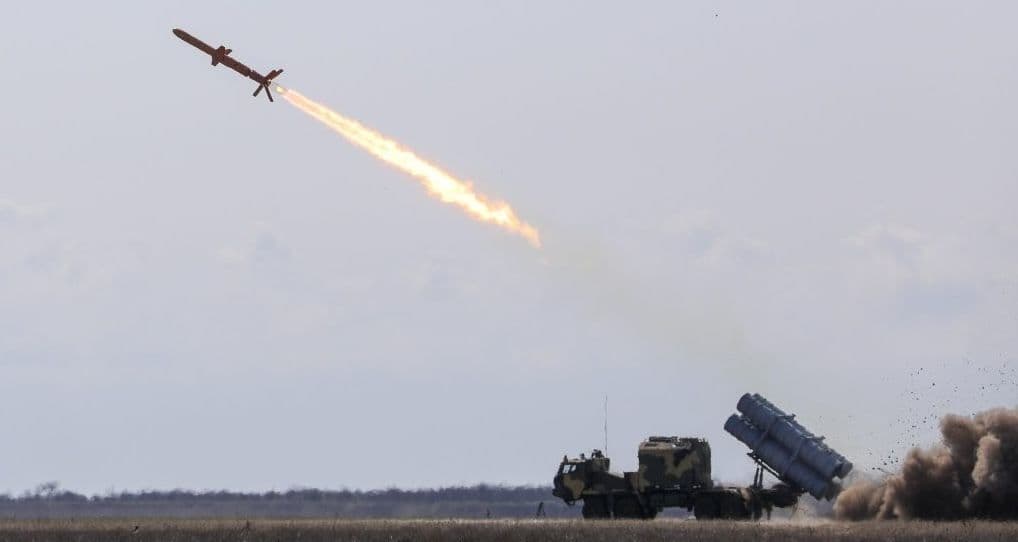
Opinion: Ukraine needs to rethink its long-range strike strategy
Ukraine faces a pivotal decision: to intensify its air campaign to deny Russia victory or to embrace a strategy of punishment that compels an end to the conflict.
A Ukrainian-made Neptune-derived cruise missile is fired from an unspecified location on April 5, 2019. (Presidential Office of Ukraine)
In 2022, Russia launched long-range strikes deep into Ukraine, confident that Ukraine could not retaliate in kind. By 2023, that situation changed. Ukraine received medium-range HIMARS rockets from the U.S., Storm Shadow and SCALP cruise missiles from the U.K. and France, and developed long-range attack drones of its own.
These rockets, missiles, and drones, used in shrewd combinations, have allowed Ukraine to strike Russian railways, roads, munitions stockpiles, maintenance facilities, storage warehouses, and fuel depots. As a result, Russia is finding it much harder to sustain and support its front-line forces.
Even so, Russia retains some real advantages. The country’s vast size has allowed it to move logistics support further to the rear, making resupply to the front line slower but still feasible. This geographic advantage means Russian weapon factories, major arms stockpiles, fuel refineries, and air bases are largely protected from regular attacks.
Additionally, Russia receives dual-use supplies from China and other foreign supporters. These materials, valuable to both civilians and the military, have been less affected by sanctions. Russian logistical losses can often be offset by external sources.
Lastly, Russia’s industrial capacity allows it to repair much of the damage from Ukraine’s limited air strikes. While these repairs may be crude, they are often effective. Repairing industrial infrastructure does divert resources away from civilian needs, affecting the Russian populace. However, this burden hasn’t yet led to significant public opposition to the war.
Operationally, Ukraine’s current air campaign is focused on oil and petroleum supplies, munitions storage, and air bases used by strike aircraft and bombers. These strikes aim to deny Russia ultimate victory, but so far, Ukraine’s attacks have been too infrequent to achieve this goal.
Strategically, Russia appears intent on continuing the war regardless of the costs in blood and treasure. Given this, an alternative strategy would be to redirect Ukraine’s air campaign toward punishment. In Russian military terms, this would involve a "Strategic Operation for the Destruction of Critical Infrastructure" — designed to pressure the population into ending the fight by making daily life unbearable.
Such attacks, however, are reminiscent of outdated air power theories from the 1920s, have questionable effectiveness, and can violate the laws of war, as seen in Russia’s attacks on hospitals in Syria and Ukraine.
More modern thinking favors targeting the leadership of a society rather than its people. This approach, though somewhat messily, worked in the 1999 Kosovo War. It is increasingly important now, as denying Russia victory outright seems unlikely. Instead, Russian leaders must be convinced it is in their best interest to end the war.
Ukraine’s new 700-km-range Hrim-2 ballistic missile and 400-km-range Neptune-derived cruise missile are entering service, both with warheads far more powerful than Ukraine’s current drones. These missiles, combined with an increasing number of long-range drones, will allow more frequent and damaging strikes. However, Ukraine must continue to prioritize targets that offer the most strategic impact.
The current approach of targeting supply chains could be enhanced by taking a systems approach and choosing which level of war the attacks might be best focused at.
At the operational level, Ukraine could concentrate on disrupting the resupply of Russian front-line forces, particularly when they are under pressure, such as during a Ukrainian offensive.
At the strategic level, Ukraine might aim to shorten the war by targeting critical manufacturing hubs that support Russia’s military, keeping in mind that these could be repaired or replaced.
At the grand strategic level, the goal would be to cripple Russia’s national economy by damaging key industries that are difficult to replace. This strategy could carry over into the post-war period, diminishing Russia’s power.
Alternatively, these new weapons could prompt a deeper rethinking of Ukraine’s air campaign. NATO’s success in Kosovo provides a model, as its airstrikes targeted dual-use infrastructure, creating widespread inconvenience, undermining morale, and persistently wearing down the population. Simultaneous strikes against the ruling elite’s property weakened their “will to war.” Together, these efforts achieved a strategically significant result.
A similar campaign against Russia would be difficult to execute and would likely require support from offensive cyber operations, diplomatic pressure, and tightened sanctions. Nonetheless, the possibility of helping to end the war is enticing.
Ultimately, Ukraine faces a choice: either enhance its air campaign to deny Russia victory or shift to a strategy of punishment to compel Russia to end the war. Neither option will be easy.
Editor’s Note: The opinions expressed in the op-ed section are those of the authors and do not necessarily reflect the views of the Kyiv Independent.














